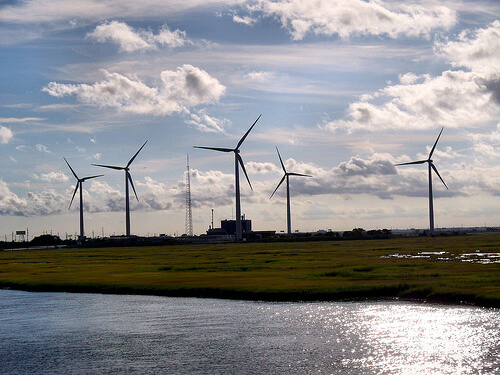Rutgers helps offshore wind firms predict coastal breezes

The way the wind blows is often inconsistent.
But a team of researchers at Rutgers University has predicted offshore sea breeze patterns on the Jersey Shore — data that could be useful for companies hoping to build wind farms off Atlantic City.
Sea breezes blow from the sea toward the beach because of the difference between warm air over land and cool air hovering above the ocean. Such gusts are already well analyzed on land, but how they play out offshore along New Jersey’s coast was a mystery.
“There’s a lot of variability in the wind,” said Greg Seroka, who got his doctorate with Rutgers’ Department of Marine and Coastal Sciences and is now a wind energy consultant for them. “And there’s no monitoring of offshore sea breezes. We have ships and buoys, but it’s less observed than on land where the people are.”
The Rutgers study, published in September, used computer models of the atmosphere to predict winds along Atlantic, Cape May and Ocean counties based on weather conditions.
Among the findings:
— Sea breezes travel three times farther offshore than onshore under certain conditions.
— Sea breezes occur offshore five hours earlier and are stronger during upwelling conditions.
— The offshore side of the sea breeze cell crosses Atlantic City’s waters at 3 p.m., regardless of conditions.
The data can be used by offshore wind developers to forecast when energy will be more available to harness and take guesswork out of their planning.
Two companies are looking to build wind farms off Atlantic City. Danish company Orsted and a joint venture between EDF Renewables and Shell Energies have submitted bids to the Board of Public Utilities proposing to build in federal waters with ratepayer subsidies.
EDF Renewables and Shell Energies want to build turbines eight miles off the coast in a 180,000-acre lease area that could generate 2,500 megawatts of wind energy. Orsted’s Ocean Wind project would be about 15 miles off the coast.
The Rutgers study has good news for them.
Sea breezes occur during hot afternoons, when people are turning on their air conditioners and demanding peak energy, Seroka said.
It also found that the breezes are stronger during upwelling conditions, when wind is blowing along the coastline and water in deeper levels of the ocean rises to the surface.
Upwelling occurs often along the New Jersey coast in the summer and fall, meaning energy companies can expect more frequent and intense gusts of wind over several months.
“New Jersey is unique in that respect,” Seroka said, “It is home to some of the strongest upwelling along the U.S. East Coast.”
The BPU approached the school to conduct the study a few years ago, Seroka said. It took on a renewed importance after Gov. Phil Murphy last year signed an executive order asking the state to create 3,500 megawatts of offshore wind energy by 2030.
The board recently wrapped up its solicitation for the first 1,100 megawatts. Three companies, including Orsted and EDF Renewables, applied for ratepayer subsidies. Their proposals have not been made public, but the BPU will choose which will receive funding by July 1.
Read the full article here.